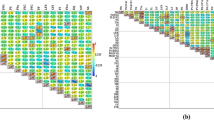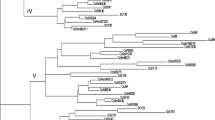Abstract
In this study, a set of one hundred tropical sugarcane genotypes were characterized by twenty-one qualitative traits. Most of the qualitative characters revealed considerable and large variation among the genotypes. The Shannon–Weaver diversity index value of all the 100 sugarcane genotypes ranged from 0.57 to 1.00. Principal component analysis for qualitative traits revealed that first nine components contributed to 64.30% variation, which has Eigen value > 1 whereas remaining components contributed for 35.70% variation. Based on diversity analysis, the genotypes were grouped into four clusters (Clusters: I: 28, II: 33, III: 20 and IV: 19). The clustered genotypes shared Co 740, POJ 2878, Co 285, CoC 671 and Co 775 as one of the common parent in their pedigree with similar qualitative traits such as auricle types, rind surface appearance and prominent growth ring. The best genotypes on basis of maximum mean values was classified as discrete, continuous and combined groups in each cluster for identifying the set of genotypes with maximum diversity for the selection of diverse donors in breeding which are to be maintained as diverse and distinct reference varieties in DUS testing of sugarcane. The qualitative traits viz., inner auricle shape, leaf blade curvature and growth crack had maximum diversity. This comprehensive morphological characterization of the genotypes with large quantity of diversity will help in the selection of clones in breeding programs and provide documentation to protect them.


Similar content being viewed by others
References
Abubakar, L., A.A. Aliero, S.G. Mohammed, S. Mohammed, M. Musa, and T.S. Bubuche. 2013. Preliminary evaluation of some qualitative traits of sugarcane germplasm of North-Western Nigeria. Nigerian Journal of Basic and Applied Science 21(2): 116–121.
Akhtar, M., N.N. Elahi, and M. Ashraf. 2001. Morphological characters of some exotic sugarcane varieties. Pakistan Journal of Biological Sciences 4: 471–476.
Alarmelu, S. 2018.Varietal Identification and description. In Manual on Best Management Practices for doubling farmer’s income: 49–63. ICAR Sugarcane breeding Institute, Coimbatore, India.
Annual report 2020–21, Department of Agriculture, Cooperation & Farmers’ Welfare. https://agricoop.nic.in/en/whatsnew
Artschwager, E. 1939. Illustrated outline for use of taxonomic description of sugarcane varieties. Proceedings of International Society of Sugarcane Technology 6: 116–128.
Artschwager, E., and E.W. Brandes. 1958. Sugarcane (Saccharum officinarum L.). Origin, classification, characteristics and description of representative clones, Agriculture Handbook No. 122, U.S. Department of Agriculture, Washington, D.C., pp 307.
Barber, C.A. 1919. The growth of sugar cane. I-III. International Sugar Journal 21: 506–510, 545–548, 601–603.
Daniel, J., and B.T. Roach. 1987. Sugarcane improvement through breeding. In Taxonomy and evolution, ed. D.J. Heinz, 7–84. New York: Elseiver.
Dhaliwal, G.S., and R. Arora. 2004. Integrated pest management: Concept and approaches. New Delhi: Kalyani Publishers.
Farooq, M. 1989. Morphological and agricultural characteristics of sugarcane in relation to mechanized agriculture at NARC Islamabad, Portu Rico Journal: 51–61.
Gashaw, E.T., F. Mekbib, and A. Ayana. 2016. Genetic diversity among sugarcane genotypes based on qualitative traits. Advances in Agriculture: 1–8.
Ghafoor, A. 1999. Genetic diversity and gene-action in Vigna mungo based on morphological and biochemical markers. Dissertation, Quaid-i-Azam University, Islamabad
Grassl, C.O. 1956. The morphology of the grass spikelet with special reference to Saccharum. In: Proceedings of the International Society of Sugar Cane Technologists 9: 764–780.
Hammer, O., A.T. David, P. Harper, and D. Ryan. 2001. PAST: Paleontological statistics software package for education and data analysis. Palaeontologia Electronica 4(1): 9.
Hemaprabha, G., S. Alarmelu, K. Mohanraj, C. Mahadevaiah, V. Raffee Viola and Bakshi Ram. 2017. Morphological Description of Coimbatore (Co) canes (1993–2016). ICAR Sugarcane breeding Institute, Coimbatore, India. https://plantauthority.gov.in/sites/default/files/sugarcane_2.pdf.
Jain, S.K., C.O. Qualset, G.M. Bhatt, and K.K. Wu. 1975. Geographical patterns of phenotypic diversity in a world collection of durum wheats 1. Crop Science 15: 700–704.
Jeswiet, J. 1918. Beschrijving der Soorten van het Suikerriet. Medeelingcn van het Proefstation voor de Java-Suikerindustrie, Landbouwkundige Serie, 5.
Karpagam, E., and S. Alarmelu. 2017. Morphological characterization and genetic diversity analysis of interspecific hybrids of sugarcane. Indian Journal of Genetics and Plant Breeding 77(04): 531–539.
Khalid, M.F., L. Khan, D. Naz, H. Nayab, A. Fayyaz, F. Gul. Samad, and R.N. Khan. 2016. Assessment of variability in sugarcane genotypes based on morphological traits. American-Eurasian Journal of Agricultural and Environmental Sciences 16(6): 1043–1050.
Lwin, A.K., K.S. Oo, and H. Nyunt. 2008. Diversity assessment of some sugarcane germplasm (Saccharum spp.) using qualitative morphological characters. In Proceedings of the seventh annual research conference: 364–382, Myanmar.
Metsalu, T., and J. Vilo. 2015. ClustVis: A web tool for visualizing clustering of multivariate data using Principal Component Analysis and heatmap. Nucleic Acids Research 43: 566–570.
Mohammadi, S.A., and B.M. Prasanna. 2003. Analysis of genetic diversity in crop plants: Salient statistical tools and considerations. Crop Science 43: 1234–1248.
Moore, P.H. 1987. Sugarcane improvement through breeding. In Morphology and anatomy, ed. D.J. Heinz, 85–142. Amsterdam: Elsevier Press.
Ong’ala, J., D. Mwanga, and F. Nuani. 2016. On the use of principal component analysis in sugarcane clone selection. Journal of the Indian Society of Agricultural Statistics 70(1): 33–39.
Panje, R.R. 1933. Saccharum spontaneum L. A comparative study of forms grown at the Imperial Sugarcane Breeding Station, Coimbatore. Indian Journal of Agricultural Science 3: 1013–1044.
Piscitelli, F.R. 1994. Principals caracteres exomorfologicos de cultures de cana de azucar. TUC Iindustraly Agricos 7: 49–57.
Rao, T.J., and U. Vijayalakshlmi. 1964. Improved canes in cultivation, 28–30. New Delhi: Indian Central Sugarcane Committee.
Sankaranarayanan, P., B.V. Natarajan, and S. Marimuthummal. 1986. Sugarcane varieties under cultivation in India. Their morphological descriptions and agricultural characteristics. New Delhi: ICAR.
Shahi, H.N. 2000. Sugarcane seed: Production and certification. In Years of sugarcane research in India, ed. H.N. Shahi, A.K. Srivastava, and O.K. Sinha, 251–260. Lucknow: Indian Institute of Sugarcane Research.
Singh, P.K., A. Siraree, S. Kumar, R.K. Singh, D.K. Pandy, and J. Singh. 2012. Characterization of sub-tropical sugarcane varieties based on distinctiveness, uniformity and stability testing guidelines of India. International Sugar Journal 114: 423–433.
Siraree, A., N. Banerjee, S. Kumar, M.S. Khan, P.K. Singh, S. Kumar, S. Sharma, R.K. Singh, and J. Singh. 2017. Identification of marker-trait associations for morphological descriptors and yield component traits in sugarcane. Physiology and Molecular Biology of Plants 23: 185–196.
Skinner, J.C. 1972. Description of sugarcane genotypes. In Botanical description. Proceedings of International Society for Sugarcane Technologists, vol. 14, pp. 124–127.
Sreenivasan, T.V., and K.V. Bhagyalakshmi. 2001. Recently released varieties. Coimbatore: Sugarcane Breeding Institute.
Stuessy, T.F. 1990. Plant taxonomy: The systematic evaluation of comparative data. New York: Columbia Univ. Press.
UPOV. 1998. Draft test Guidelines for sugarcane. Union Internationale Pour La Protection Des Obtentions Vegetales (UPOV), Geneva, Switzerland. p. 3–30.
Acknowledgements
The authors are grateful to Dr. G. Hemaprabha, Director and Head, Division of Crop Improvement, ICAR-SBI for providing necessary facilities to carry out this research work. The authors also gratefully acknowledge Protection of Plant Varieties & Farmer’s Rights Authority (PPV &FR), New Delhi for the funding to carry out the research at ICAR-SBI.
Author information
Authors and Affiliations
Contributions
All authors contributed to the study conception and design. Material preparation, data collection and analysis were performed by AS, JC, Anusheela Varadaraju, Aravindhan Veerasamy, and KR. All authors read and approved the final manuscript.
Corresponding author
Ethics declarations
Conflict of interest
The authors declare that they have no conflict of interest.
Additional information
Publisher's Note
Springer Nature remains neutral with regard to jurisdictional claims in published maps and institutional affiliations.
Supplementary Information
Below is the link to the electronic supplementary material.
Rights and permissions
Springer Nature or its licensor holds exclusive rights to this article under a publishing agreement with the author(s) or other rightsholder(s); author self-archiving of the accepted manuscript version of this article is solely governed by the terms of such publishing agreement and applicable law.
About this article
Cite this article
Srinivasan, A., Chellappa, J., Varadaraju, A. et al. Genetic Diversity Analysis in Tropical Sugarcane Genotypes Using Morphometric Traits. Sugar Tech 25, 430–439 (2023). https://doi.org/10.1007/s12355-022-01215-2
Received:
Accepted:
Published:
Issue Date:
DOI: https://doi.org/10.1007/s12355-022-01215-2




